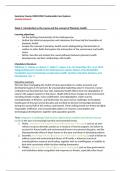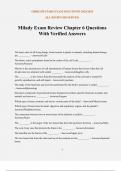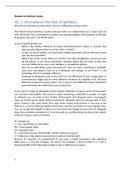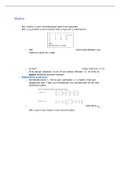Chapter 1: Introduction
Banks are heavily regulated institutions and therefore risk management is even more
important for them than other institutions. Risk management is important for the bank itself
as it does not want to go bankrupt. It is also important for society as banks are very
important for them. For banks, there are special elements to risk. They do not have very high
equity capital, thus if they take a risk and make a large loss, they can easily go bankrupt.
Risk vs return for investors
When considering a new venture you need to look how it fits in the portfolio: how it correlates
with the rest of the business. Risk management is to understand portfolio risk and future risk
plans.
There is a trade-off between risk and expected return. The greater the risk taken, the higher
the expected return. The expected value is the weighted average of possible returns. Where
the weight is the probability of that return occuring.
Measure of risk: std deviation of the return over one year:
√ [E(R2) - risk]
Where R is the annual return and E denotes expected value. To calculate E(R2), we weigh
the squared returns by their probabilities.
Expected return of a portfolio:
UP = w1U1 + w2U2 -> where u is expected return
Standard deviation of a portfolio:
σP = √ [w12 * σ12 + w22 * σ22 + 2 * ⍴ * w1 * w2 * σ1 * σ2]
Where rho (⍴) is the correlation coefficient
Most investors are risk-averse. They want to increase expected return while reducing the
stdv of return. They want to move in the northwest direction on the efficient frontier.
The efficient frontier
Efficient frontier:
It represents the limits of how far we can move in a northwest direction. There is no
investment that dominates a point on the efficient frontier in the sense that it has both a
higher expected return and lower stdv of return.
1











